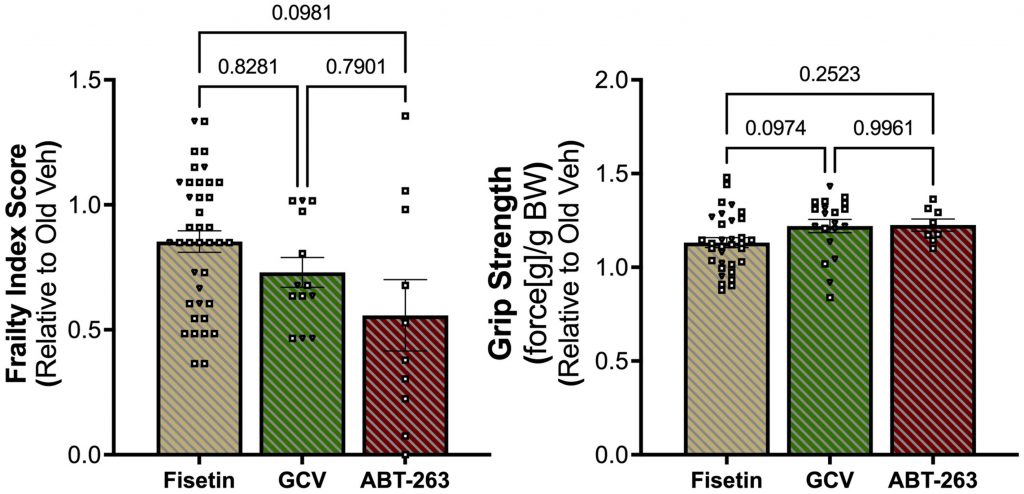Key Points:
- Fisetin reduces vulnerability to disability and disease while improving strength.
- Fisetin’s effectiveness is comparable to pharmaceuticals and genetic modifications that target age-promoting senescent cells.
As we age, simple tasks become more challenging, muscles weaken, and a general sense of vulnerability can set in. This decline in physical function has a significant impact on our quality of life and independence. But what if there was a way to slow down, or even reverse, some of these age-related changes? Recent scientific research is pointing towards exciting possibilities, particularly in the realm of compounds known as ‘senolytics’.
Senolytics
Central to age-related decline are what scientists call senescent cells — cells that accumulate in tissues and release harmful molecules that contribute to inflammation and organ damage. Senescent cell accumulation accelerates the aging process and leads to age-related conditions like muscle weakness. Fortunately, researchers have discovered compounds that selectively eliminate senescent cells — senolytics — potentially paving the way for healthier aging.
Among the various senolytics being investigated, a naturally occurring compound called fisetin has garnered significant attention. Fisetin is a flavonoid, a type of plant pigment found in many fruits and vegetables. Strawberries contain the highest concentration of fisetin (160 µg/g), but you’d need to eat a lot of them to get a therapeutic dose. For this reason, concentrated forms of fisetin are being studied for their potential health benefits.

Fisetin Reduces Frailty and Increases Strength
A new study published in Aging Cell delves into the exciting findings surrounding fisetin’s impact on physical function and cellular aging in mice. This study offers compelling preclinical evidence that fisetin could be a powerful tool in our quest for healthier, more active later years. The researchers in this study orally administered fisetin to old mice using an intermittent treatment schedule – one week on, two weeks off, then one week on again. This mimics an approach used in a clinical trial, aiming to clear senescent cells without disrupting the body’s natural processes where these cells might be beneficial.
The results were promising, as researchers observed significant improvements in the physical function of old mice treated with fisetin. Specifically, these mice showed a reduction in frailty, a state of increased vulnerability to adverse health outcomes. Frailty was measured using a comprehensive frailty index (FI) that assesses various aspects of physical health, encompassing many different organs and tissues.
The fisetin-treated old mice also demonstrated a notable increase in grip strength, an indicator of muscle strength and physical capability. Moreover, in humans, a stronger grip predicts a longer life. Thus, this finding suggests that fisetin can directly impact strength, which is vital for movement, daily activities, and longevity.

Interestingly, fisetin had no discernible effects on young mice, reinforcing the idea that its benefits are specifically related to combating age-associated cellular changes. This is a crucial point, as it suggests fisetin is targeting the problems that arise with aging, rather than simply boosting performance in already healthy, young organisms.
Beyond these observable physical improvements, the study also delved into the molecular mechanisms at play. By analyzing the gene expression in the quadriceps muscles of the mice, the researchers found that fisetin treatment led to a reduction in the expression of genes associated with cellular senescence, supporting the idea that fisetin is indeed working by clearing senescent cells and reducing their harmful impact on muscle tissue. The authors conclude,
“Our findings suggest that treatment with fisetin may be a viable therapeutic approach to improve physical function and reduce excess cell senescence in skeletal muscle with aging.”
Fisetin: A Natural Alternative to Other Senolytics?
A compelling aspect of the study was a comparison between fisetin and other established senolytic approaches. The study compared fisetin’s effects to the genetic clearance of senescent cells, which involved using genetically modified mice (p16-3MR mice) where senescent cells are specifically removed. This method is considered a gold standard for demonstrating the benefits of senescent cell clearance. Fisetin was also compared to the synthetic senolytic ABT-263, also known as Navitoclax, an anti-cancer pharmaceutical drug.
Remarkably, the improvements in frailty and grip strength observed with fisetin treatment were comparable to those achieved through both genetic clearance and treatment with ABT-263. This finding is highly significant because it suggests that fisetin, a natural compound, can be as effective as more targeted or synthetic approaches in improving age-related physical function.

This comparability is particularly exciting given the potential side effects associated with some synthetic drugs. Fisetin, being a natural flavonoid found in foods, may offer a potentially safer and more accessible alternative for targeting cellular senescence in aging populations. While the doses used in the study are higher than what can be obtained through diet alone, the natural origin of fisetin makes it an attractive candidate for further development.
From Mice to Humans
While these findings are promising, it is important to remember that this study was conducted in mice. The next crucial step is to translate these results to humans. Researchers will need to conduct more clinical trials to confirm fisetin’s safety and efficacy in people, determine optimal dosages, and understand its long-term effects.
While this study primarily focused on muscle and physical function, the same research group showed that intermittent supplementation with fisetin improves arterial function in old mice. Considering that senescent cells accumulate in multiple organs during aging, one could imagine the possibility of fisetin improving multiple age-related diseases. More studies testing the effects of fisetin on the function of different organs (e.g., the brain) in old mice could reveal that fisetin counteracts body-wide aging.
This research provides compelling preclinical evidence for fisetin as a powerful natural senolytic. Its ability to improve physical function and reduce cellular senescence in aging muscle, comparable to more established senolytic strategies, positions it as a promising candidate for future anti-aging interventions.